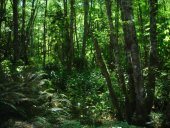According to some websites, there's nothing wrong with old nettle leaves, other than being chewy, as the cystoliths do not actually lead to kidney stones (
http://www.eattheweeds.com/bet-your-life-on-it-myth-busting/). I really hope this is true, as I thoroughly enjoy nettles the whole time they are growing. I haven't really noticed any change in flavor or toughness as the season progresses. They are always good (in my mind) fried or baked in duck fat or coconut oil to make "nettle chips." Oh, how I love those!
Speaking of, I went looking for nettles poking up out of the ground. No luck

. Their delayed development is sad, but understandable--as because I'm 500 feet above sea-level and on a north-facing, forested hill. I did, however, notice an odd occurance. One of the nettle stalks got pushed over and bent last year, and now has a little stalk growing out of the bend. Weird!










